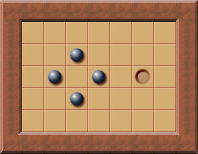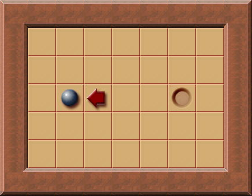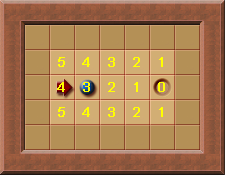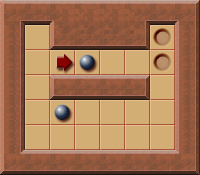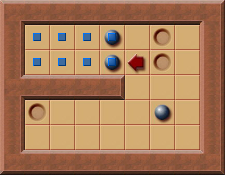Solver
From Sokoban Wiki
Contents |
Data structures
Positions on the board
The board is a 2 dimensional area containing the objects of a Sokoban level. Hence, a natural data structure to store the board is a two dimensional array. However, many solvers use a 1 dimensional data structure for this task, numbering all board positions from 0 to x. This has the advantage that a specific position can be stored in just one variable. The board data structure can also include additional data like: Is a box frozen Is a position a dead position
Storing a state
In Sokoban a state consists of the positions of the boxes and the position of the player. Every other element of the board cannot change its position and therefore needn’t to be stored per state. Therefore a state can be stored by using: One integer array for storing all box positions. One integer for storing the player position. For a better memory alignment the player position and box positions can also be stored in one integer array together. The data structure usually consists of additional data fields like for storing information about the state like pushes needed to reach it or which box has been pushed last. Example data structure for Java: public class State { int[] boxPositions; int playerPosition; }
Transposition Tables
Solvers for the Sokoban game use a graph search as the search algorithm. The search creates a directed graph of states. In nearly every Sokoban puzzle many states can be reached through different paths in the search graph. In these cases the graph is cyclic and the search reaches specific states multiple times during the search. The search effort can therefore be considerably reduced by eliminating duplicate states from the search. A common technique is to use a large hash table, called the transposition table, which stores all already explored states. The transposition can also be used to store additional data per state – for instance the depth the state has been reached in during an IDA*-search.
Tradeoff between space and time
The transposition table may need to hold several million states. Hence, an efficient data structure has to be chosen for storing the states.
There are different approaches to address the high memory usage problem.
Limit the transposition table size
One solution for the high memory usage of the transposition is limiting the size of the transposition table. This makes the search algorithm a kind of hybrid between tree search and graph search. The advantage is the ability to search for solutions for larger levels due to the lower memory usage, while an obvious disadvantage is that it may lead to duplicated search effort.
Incremental storage of states
Instead of storing all box positions and the (normalized) player position for every state it’s also possible to store the data relative to another state. This divides the states in two types: States that store all box positions and the player position. States that store a link to another state and the difference to that linked state.
Example: A state consists of these data: State 1: box positions: 10, 13, 21, 33, 45, 47, 48, 49 player position: 17
Now another state consisting of these data has to be stored:
State 2: box positions: 11, 13, 21, 33, 45, 47, 48, 49 player position: 10
State 2 can be stored relative to state 1 this way:
State 2: link to: state 1 boxNo: 0 newBoxPosition: 11 Player position: 10
Normalizing the player position
Solvers not interested in finding solutions optimized for moves can consider two states equivalent if the boxes are at the same positions and the player positions are in the same player access area.
This can be implemented by storing only normalized player positions, e.g. the top-left reachable position instead of the actual position of the player.
This significantly reduces the number of states in the search tree.
Calculation of player reachable positions
The reachable player positions must be calculated very often during the solver search. Hence, an efficient algorithm is required.
Algorithm
In order to generate successor states from a specific state during the search the solver must know which side of which boxes the player can reach. Instead of calculating a path for the player to every side of every box separately it’s quicker to calculate all player reachable positions at once. This can be done by performing a simple Breadth First Search. The BFS marks all reachable positions. This can be done by using a boolean array where each bit represents a specific position on the board. For a better performance time stamps can be used to mark the reachable positions of the player instead of boolean flags.
Brute force
The first step we do is to code a routine that generates all possible pushes for a given level situation. In our level for the first push there are four possible pushes: up, down, left and right. All of these pushes are done and the resulting states are stored in a queue.
With only one push the box can be pushed to the following positions:
After this is done we take every of these saved states as new start state and generate all possible successor states. For example, this is one state than occurs after the first push has been made:
We take this state and generate all successor states of it (that just means we push the box to every possible direction again). Again we save every generate state in the queue.
Described as algorithm this looks like this:
This is done again and again:
- Add the initial state (the level begin) to the queue
- Take the first state of the queue
- Generating all successor states of the state we got of the queue
- Add all states we've just generated in the queue
- continue by step 1
Finally we reach the state where the box is located on the goal.
Pruning duplicate positions
The described algorithm can be improved a lot. One thing that can be improved is the following: At any time the algorithm pushes the box on square to the right. Then it adds this state to the queue. At some time it takes this state from the queue again and generates all successor states - including the state resulting by pushing the box one square to the left. This results in a loop: Pushing a box to the right, then back to the left, again to the right, ... we generate duplicate positions which slows down the search a lot. So what we have to do is avoiding duplicates states. To avoid duplicate positions we have to detect them. Therefore we have to store every state reached during the solving process. After a new state has been generated we have to check if it has already been generated before and if so we just discard it. This reduces the number of states to search until a solution is found a lot and therefore improves the performance of the solver.
New solver process logic:
- Take the first state of the queue
- Generating all successor states of the state we got of the queue
- Delete all successor states that have already been generated before
- Add all left states to the queue
- continue by step 1
Detecting deadlocks
During the search the solver will generate states that are deadlocks. That means the level can't be solved from this point on, no matter how we push the box. See the Deadlocks section for an overview of some common deadlocks that may occur. To avoid deadlock states and thus reducing the number of states to be searched we now have a new process logic:
- Add the initial state (the level begin) to the queue
- Take the first state of the queue
- Generating all successor states of the state we got of the queue
- Delete all successor states that have already been generated before
- Delete all successor states that are deadlock
- Add all left states to the queue
- continue by step 1
Lowerbound
Having a look at our test level we (as humans) just "see" that only pushes to the right are pushes that let us come closer to a solution. A push to the left is useless. What do we "see" here ? Well, we see, that the goal is on the right side. If we want to get to something that is right to us we won't go to the left :-) So let us teach the solver to be intelligent enough to recognize which direction it should prefer. Therefore we calculate for every square how many squares it is away from the goal:
Every time the solver generates a new state it takes the number stored at the square the box is located after the push. For instance: At the start of the level (initial state) the player may push the box on square to the left. The new state is saved in the queue - and, the number of the square the box now is located at is stored in the queue (in this example it would be "4"). The number represents the distance of a specific square to the goal and is saved together with a state in the queue.
The next time the solver takes a state from the queue it takes the state having the lowest stored distance!
Here it is in detail. Let's assume every square in the level has a coordinate. The player is located at position: 3, 4 for example and the goal is located at 7, 4.
The solver takes the initial state out of the queue and generates all successors. It also saves the distance together with every state. From the initial state the solver generates these four successor states (the order is arbitrarily):
| State | box position | distance to goal |
|---|---|---|
| 1. | 4,3 | 4 |
| 2. | 3,4 | 4 |
| 3. | 4,5 | 4 |
| 4. | 5,4 | 2 |
The solver now won't take the first state of the queue but the one having the lowest distance to the goal, this is state number 4.
This way it prefers the path to the right and generates fewer states until it finds a solution for this level. It takes state 4 from the queue and generates its successor states. Again the distances are stored together with the successor states in the queue. And again the state with the lowest distance is take from the queue next. This way we reduce the number of generated sates during the solving process.
To ensure that the solution we found is the solution with the fewest possible pushes, the distance should also consider the distance from the start state. For example, the distance could be the estimated solution length. It is calculated as distance_from_start + underestimated_distance_to_goal. The underestimation ensures that no shorter solution will be missed.
No influence pushes (tunnels)
Having teached the solver to use the algorithms described above our little level is solved very quickly. Usually Sokoban levels are a lot more complicated. Therefore we have to search for further ideas how to reduce the number of states we have to generate during the solving process.
New example level:
Here we have a (still very easy) level containing two boxes. The solver takes the given state as initial state. Then it generates all possible successor states. This means: Pushing box 1 to every possible direction AND pushing box 2 to every possible direction. The solver doesn't know which push is the best for solving the level - hence it has to generate all possible successor states. This soon leads to an enormous number of generated states (at least in larger Sokoban levels). It would be a great advantage if we knew that only pushes of one box are relevant in a specific state.
Let's assume the player has just pushed the box next to him one square to the right. What to do next?
The solver will consider every possible next push: all possible pushes of the higher box and all possible pushes of the lower box. But: The higher box is in a tunnel - the just performed push has been a "no influence push". The reason is: The squares the lower box can ever be pushed to stayed the same. There aren't any additional squares the lower box can reach, nor are there any squares the lower box can't reach due to the push of the higher box. The just pushed box has definitely to be pushed sooner or later. So there is no reason why not to push it further to the right immediately!
In general such a "no influence push" is always created when the situation AFTER the push looks like this (or any flipped / mirrored version of it):
Every time a push of a box results in such a situation the box can immediately be pushed one square further! This rule can reduce the number of states to be generated in some levels a lot.
ICorrals
Tunnels can reduce the number of boxes to consider for the next push to only one. Thus, the solver is generating either all possible pushes of all boxes (normal case) or just the possible pushes of just a specific box (box in a "tunnel"). Is there any thing in between ? Yes, it is.
In this level the player just has pushed the box to the left.
Normally the solver now generates all possible pushes for all boxes including the box in the lower right corner.
The push created the corral (area the player can't reach) marked with a ![]() .
The boxes involved in this corral can only be pushed inside this corral (= on squares that are marked).
All pushes of these two boxes don't influence the other box. One of the pushes that lead to the inside of the corral has to be done sooner or later - and there is no reason why it can't be done immediately!
.
The boxes involved in this corral can only be pushed inside this corral (= on squares that are marked).
All pushes of these two boxes don't influence the other box. One of the pushes that lead to the inside of the corral has to be done sooner or later - and there is no reason why it can't be done immediately!
Hence, the solver just has to generate all possible pushes for the boxes involved in an ICorral!
This can reduce the possible pushes a lot particularly when there are a lot of boxes in the level that aren't involved in the ICorral.
YASS Solver
Sokoban solver "scribbles" by Brian Damgaard about the YASS solver
Limited search
Ideas by David Holland on computer solving by limited search are linked below. They aren't fully wikified yet as author has RSI. Features new concepts such as free space, shuffling, relocation and generalized deadlock detection. Sketches of algorithms included. Other new concepts such as goal traps with algorithms may be implemented in existing solvers. Author hopes other programmers will discuss and implement what they find relevant. Limited search as opposed to exhaustive search uses macros, heuristics and domain-specific knowledge to effectively search deeper in the tree of positions by not looking at every position. A new category of "Planner" plug-in is suggested for limited search to be tried when the Solver plug-in fails, indicating too large a tree. David Holland's computer Sokoban solving ideas
